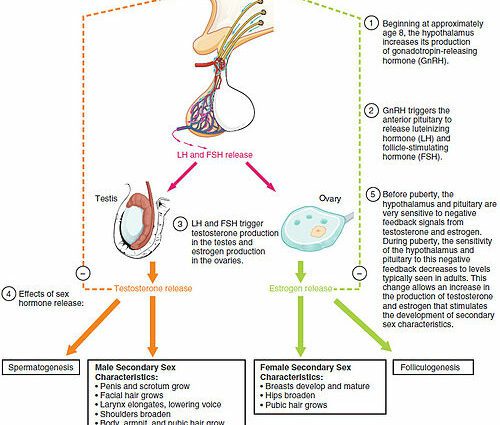Contents
LH or Luteinizing Hormone
In both men and women, the luteinizing hormone or LH plays a key role in fertility. It is indeed part of the hormones known as gonadotropins, conductors of the reproductive glands. A disorder in its secretion can therefore be an obstacle to becoming pregnant.
What is luteinizing hormone or LH?
Luteinizing hormone or LH (luteizing hormone) is secreted by the anterior pituitary. It is part of the gonadotropins: it controls, along with other hormones, the sex glands (gonads), in this case the ovaries in women and the testes in men.
In women
Along with follicle stimulating hormone (FSH), LH plays a key role in the ovarian cycle. It is precisely the LH surge that will trigger ovulation during a series of chain reactions:
- the hypothalamus secretes gnRH (gonadotrophin releasing hormone) which stimulates the pituitary gland;
- in response, the pituitary gland secretes FSH during the first phase of the cycle (from the first day of menstruation to ovulation);
- under the effect of FSH, certain ovarian follicles will begin to mature. The ovarian cells located around the maturing ovarian follicles will then secrete more and more estrogen;
- this increase in the level of estrogen in the blood acts on the hypothalamic-pituitary complex and causes the massive release of LH;
- under the effect of this LH surge, the tension in the follicle increases. It eventually breaks and expels the oocyte into the tube: this is ovulation, which takes place 24 to 36 hours after the LH surge.
After ovulation, LH continues to play a vital role. Under its influence, the ruptured ovarian follicle transforms into a gland called the corpus luteum which in turn secretes estrogen and progesterone, two hormones essential in early pregnancy.
In humans
Like the ovaries, the testes are under the control of FSH and LH. The latter stimulates the Leydig cells which are responsible for the secretion of testosterone. LH secretion is relatively constant after puberty.
Why take an LH test?
LH dosage can be prescribed in different situations:
In women
- in the presence of signs of precocious or late puberty;
- in the event of menstruation disorders;
- in case of difficulty conceiving: a hormonal assessment is systematically carried out as part of the infertility assessment. It comprises in particular the determination of LH;
- detecting the LH surge in the urine also makes it possible to identify the day of ovulation, and therefore to determine his fertility window in order to optimize his chances of conception. This is the principle of ovulation tests sold in pharmacies;
- on the other hand, the LH assay is of no interest in the diagnosis of menopause (HAS 2005) (1).
In humans
- in the presence of signs of precocious or late puberty;
- in case of difficulty conceiving: a hormonal assessment is also systematically carried out in men. It includes in particular the LH assay.
LH assay: how is the analysis carried out?
LH is assayed from a simple blood test. In women, it is performed on the 2nd, 3rd or 4th day of the cycle in a reference laboratory, at the same time as the FSH and estradiol assays. In the event of amenorrhea (absence of periods), the sample can be taken at any time.
In the context of a diagnosis of late or precocious puberty in a young girl or boy, the urine dosage will be preferred. The gonadotropins FSH and LH are secreted in a pulsatile fashion during the puberty period and are eliminated intact in the urine. Urinary dosage therefore makes it possible to better assess the secretion levels than a punctual serum dosage.
LH level too low or too high: analysis of the results
In children
High levels of FSH and LH can be a sign of precocious puberty.
In women
Schematically, a high LH level leads to a primary ovarian deficit (a problem with the ovaries themselves causing gonadal insufficiency) which may be due to:
- a congenital anomaly of the ovaries;
- a chromosomal abnormality (Turner syndrome in particular);
- treatment or surgery that affected ovarian function (chemotherapy, radiotherapy);
- polycystic ovary syndrome (PCOS):
- thyroid disease or adrenal disease;
- an ovarian tumor.
Conversely, a low LH level leads to a secondary ovarian disorder of high origin (hypothalamus and pituitary) leading to a deficiency in gonadal stimulation. One of the most common causes is the prolactin pituitary adenoma.
In humans
An abnormally high level of LH directs the diagnosis towards primary testicular failure which may be due to:
- a chromosomal abnormality;
- a lack of development of the testes (testicular agenesis);
- testicular trauma;
- an infection ;
- treatment (radiotherapy, chemotherapy);
- a testicular tumor;
- an autoimmune disease.
A low LH level returns to a disorder of high origin, in the pituitary and hypothalamus (pituitary tumor for example) leading to secondary testicular failure.










